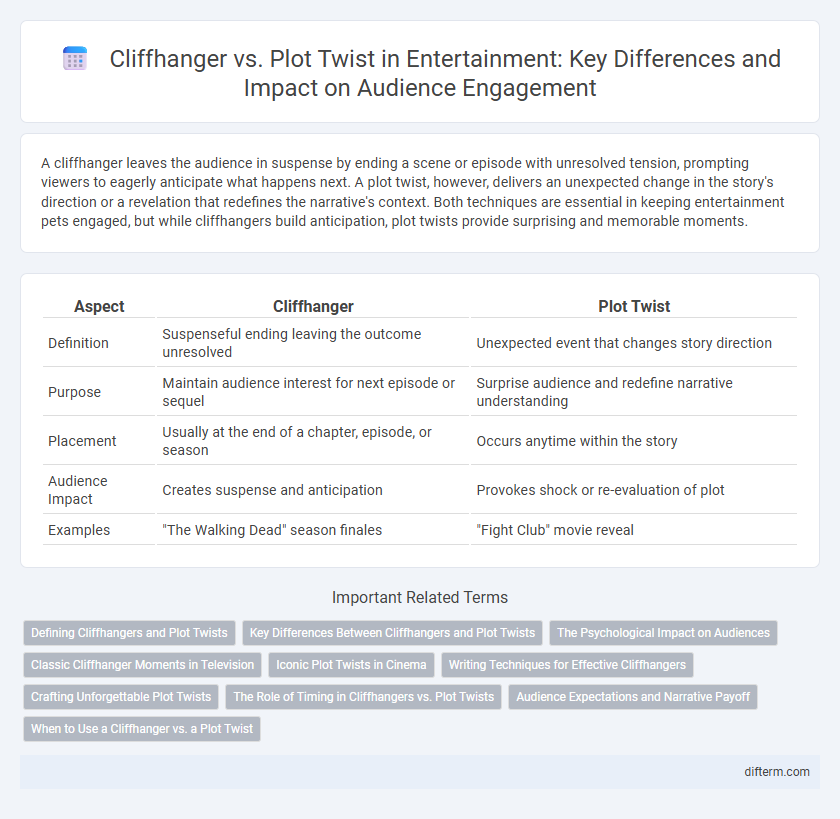A cliffhanger leaves the audience in suspense by ending a scene or episode with unresolved tension, prompting viewers to eagerly anticipate what happens next. A plot twist, however, delivers an unexpected change in the story's direction or a revelation that redefines the narrative's context. Both techniques are essential in keeping entertainment pets engaged, but while cliffhangers build anticipation, plot twists provide surprising and memorable moments.
Table of Comparison
| Aspect | Cliffhanger | Plot Twist |
|---|---|---|
| Definition | Suspenseful ending leaving the outcome unresolved | Unexpected event that changes story direction |
| Purpose | Maintain audience interest for next episode or sequel | Surprise audience and redefine narrative understanding |
| Placement | Usually at the end of a chapter, episode, or season | Occurs anytime within the story |
| Audience Impact | Creates suspense and anticipation | Provokes shock or re-evaluation of plot |
| Examples | "The Walking Dead" season finales | "Fight Club" movie reveal |
Defining Cliffhangers and Plot Twists
Cliffhangers create suspense by leaving a story unresolved at a critical moment, compelling audiences to return for the next installment. Plot twists introduce unexpected changes in the narrative, altering the audience's perception of events or characters. Both techniques heighten engagement but serve different narrative purposes: suspense versus surprise.
Key Differences Between Cliffhangers and Plot Twists
Cliffhangers create suspense by leaving a narrative unresolved at a critical moment, compelling audiences to return for the conclusion, whereas plot twists reveal unexpected developments that alter the story's direction or character understanding. Cliffhangers are typically positioned at the end of episodes or chapters to maintain engagement over time, while plot twists occur within the narrative to shock or surprise viewers. Both storytelling devices enhance dramatic tension but serve distinct functions: cliffhangers hinge on anticipation, and plot twists rely on revelation.
The Psychological Impact on Audiences
Cliffhangers create intense suspense by leaving key plot points unresolved, triggering anxiety and anticipation that heighten emotional engagement and compel viewers to return. Plot twists disrupt expectations suddenly, causing cognitive reevaluation and emotional surprise that can deepen investment in the narrative. Both techniques manipulate psychological responses to enhance storytelling impact and audience retention.
Classic Cliffhanger Moments in Television
Classic cliffhanger moments in television, such as the shocking season finale of "Dallas" revealing "Who shot J.R.?," create intense anticipation that keeps audiences eagerly awaiting the next episode. These cliffhangers differ from plot twists by leaving key storylines unresolved rather than altering the narrative direction unexpectedly, fostering suspense over time. Iconic examples include the frozen logo fade-out in "Lost" and the near-death suspension in "The Sopranos," which have become defining features of serial storytelling in entertainment.
Iconic Plot Twists in Cinema
Iconic plot twists in cinema, such as the revelation of Darth Vader as Luke's father in Star Wars or the unexpected identity of Keyser Soze in The Usual Suspects, dramatically reshape audience perceptions and narrative trajectories. Unlike cliffhangers that leave stories unresolved to entice viewers back, plot twists provide a definitive shock that redefines the storyline's meaning. These moments become cultural touchstones, elevating films into legendary status by delivering unforgettable surprises that resonate long after the credits roll.
Writing Techniques for Effective Cliffhangers
Effective cliffhangers utilize suspenseful pacing, unresolved conflicts, and strategic withholding of key information to keep audiences eagerly anticipating the next segment. Writers often employ emotional stakes and sudden revelations at the end of chapters or episodes to maximize tension and engagement. Combining these techniques enhances narrative momentum and deepens viewer or reader investment in the story's outcome.
Crafting Unforgettable Plot Twists
Crafting unforgettable plot twists involves subverting audience expectations through carefully planted clues and misdirection, enhancing narrative impact without sacrificing coherence. Unlike cliffhangers that pause tension at a critical moment, plot twists redefine the story's trajectory and character motivations, increasing emotional engagement and thematic depth. Effective plot twists require a balance of surprise and inevitability, ensuring that revelations feel both shocking and plausible within the established story world.
The Role of Timing in Cliffhangers vs. Plot Twists
Timing in cliffhangers is crucial as they are typically placed at the end of episodes or chapters to create suspense and encourage continued engagement. Plot twists, however, can occur at any point in the narrative, dramatically altering the story's direction and character motivations. Effective use of timing in both techniques heightens emotional impact and viewer investment in entertainment media.
Audience Expectations and Narrative Payoff
Cliffhangers generate suspense by leaving key story elements unresolved, heightening audience anticipation for the next installment. Plot twists subvert expectations by revealing surprising information that recontextualizes the narrative, delivering a memorable payoff. Both devices manipulate audience engagement but differ in timing and impact, with cliffhangers sustaining tension and plot twists providing abrupt cognitive shifts.
When to Use a Cliffhanger vs. a Plot Twist
Cliffhangers should be used at the end of episodes or chapters to create suspense and compel the audience to return for more, effectively enhancing engagement through unresolved tension. Plot twists work best within the narrative middle or climax, surprising viewers by subverting expectations and adding depth to the storyline. Strategic placement of cliffhangers and plot twists ensures dynamic pacing and emotional investment in entertainment content.
cliffhanger vs plot twist Infographic

 difterm.com
difterm.com